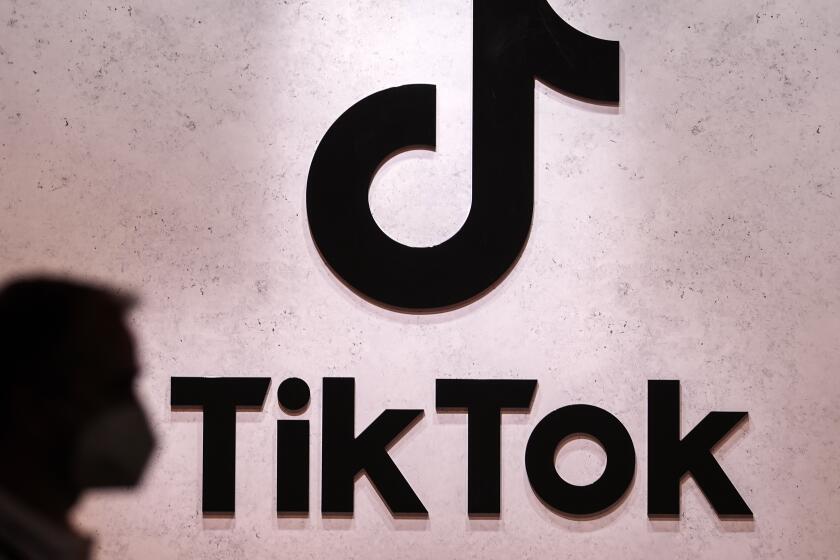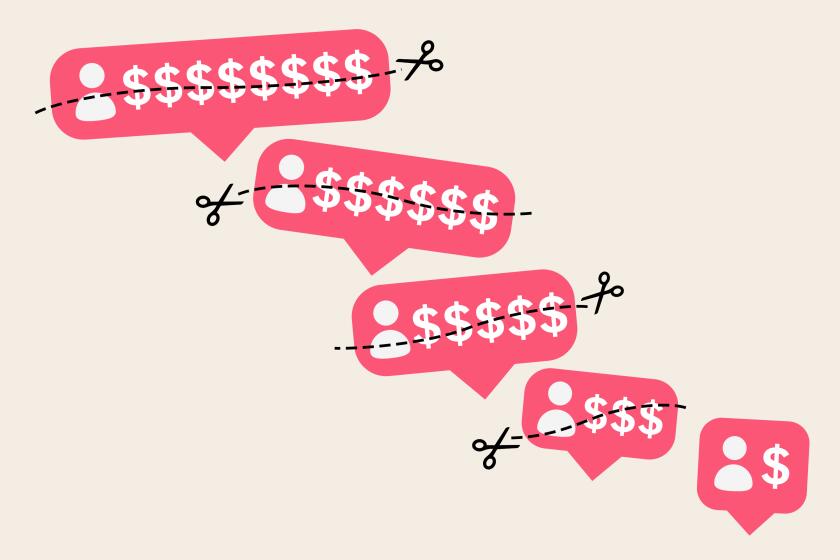Congress is threatening to ban TikTok. Here’s what you should know

- Share via
The House of Representatives’ lopsided vote Wednesday in favor of a bill banning TikTok in the U.S. unless it is freed from Chinese control suggests the wildly popular short-video app could soon join Netscape and Myspace in the dustbin of history.
But the situation is far more complicated than that.
Policymakers agree that TikTok poses unique privacy and security threats because of the Chinese government’s influence over its owner, Beijing-based ByteDance. But the app has a powerful, albeit newly converted, backer in former President Trump, meaning that Republicans who would ordinarily support any bill to lessen Chinese influence are torn on the TikTok proposal.
Beyond that, TikTok captures the attention of an estimated 150 million Americans each month, roughly half of whom are active users, making it one of the most popular apps in the country — despite concerns about privacy, misinformation and harm to young users. The potential ban has drawn fiery objections from across the country, including from entrepreneurs, small businesses and marketers who say it would be a financial shock.
Some opponents of a ban have called it a violation of the 1st Amendment. Others wondered why TikTok was being singled out as a threat, considering how many apps hoover up their users’ personal data. And some argued that the bill would benefit only U.S. tech giants Meta, the owner of Facebook and Instagram, and Alphabet, the owner of YouTube.
Here’s a quick rundown of what’s happening and why, and what it means for TikTok users.
The House has passed a bill that would lead to a nationwide ban on the popular video app TikTok if its China-based owner doesn’t sell.
What does the bill seek from TikTok?
The House-passed bill seeks to do the same thing Trump sought to do as president: take TikTok out of the hands of a Chinese company subject to Chinese law. The Trump administration went so far as to ban TikTok in the United States in 2020. That order was blocked by two federal courts, however, which held that the administration had overstepped its authority.
ByteDance, an internet-focused, venture-capital-funded startup founded in China in 2012, owns 100% of TikTok. Although outside investors control 60% of ByteDance, according to Axios, the Chinese company retains operational control.
The new bill, which sped through the House, would prohibit companies from distributing, maintaining or updating a “foreign adversary controlled application,” or providing internet hosting services for companies that do any of those things. It defines “foreign adversary controlled application” as ByteDance, TikTok and its successors, although it would give the president the power to name other social media and communications apps with 1 million or more users that are controlled by people residing in a “foreign adversary country.”
If passed by the Senate and signed into law, the measure would give ByteDance 180 days to end Chinese control, which would require it to limit Chinese investors to a 20% stake in the company. That would probably require ByteDance to spin off TikTok into an independent company with more limited Chinese investment.
If ByteDance did not comply, the bill would require it to let users retrieve all their data, including all information about their preferences, views and uploads, in a format that could be transferred to another social media app.
Worsening economic conditions could be a stress test for the burgeoning influencer economy. But online creators are pivoting by telling viewers what not to buy.
Who uses TikTok?
According to Pew Research Center, 33% of U.S. adults said last year that they use TikTok. That’s a lot of people, yet it pales in comparison with the number using other major social media platforms. According to Pew, 83% of U.S. adults said last year that they use YouTube and 47% said they use Instagram.
Young people are far more likely to use TikTok than their parents, but even they make heavier use of YouTube and Instagram. According to Pew, 62% of 18- to 29-year-olds say they use TikTok, as do 63% of 13- to 17-year-olds.
“To me, TikTok is modern-day television and so any kind of disturbance of it would really hurt people — not just creators — because people really enjoy it,” said television personality Foodgod, formerly known as Jonathan Cheban.
Foodgod, who has 8.5 million followers for his food and lifestyle videos on TikTok, said he cycles through the social media apps on his phone every hour and enjoys the more casual vibe on TikTok. Banning it, he said, would be “literally like going into someone’s room and ripping their TV out of the wall, which I think is insane.”
“But honestly, I think TikTok is here to stay. There’s too many people on it and too many people love it,” he said. “It feels like you’re so much freer on TikTok to do what you want. It’s not like Instagram — everything is so structured and you have to make it perfect.”
Could the government really ban TikTok?
Passing the Senate might be the smallest hurdle remaining for a TikTok ban.
ByteDance and other opponents of the bill are almost certain to challenge it in court on 1st Amendment grounds, just as they successfully challenged Montana’s attempt to ban the app. Defenders of the bill say it doesn’t impinge on free speech because it targets ByteDance’s conduct, not the content on the app. But critics counter that the bill wouldn’t protect Americans from having their data harvested by foreign interests.
Telecom industry experts say that it’s technically possible to ban TikTok, but there are issues.
First, the bill wouldn’t remove TikTok from the phones that already have it. It would, however, bar companies from providing TikTok updates, which could render the app unusable over time as phone operating systems change.
Second, although the bill would force Google Play and Apple’s App Store to stop distributing TikTok’s app in the U.S., it wouldn’t apply to non-U.S. sources of phone software, nor would it be easy to enforce on unofficial sites online. So the app and its updates would remain available to people willing and able to “sideload” them from such sources.
That’s not hard on an Android phone, but on an Apple iPhone, it’s trickier — at least for now. Apple has just started allowing a form of sideloading in Europe, in response to the European Digital Markets Act.
There’s a trade-off to this approach, however, said Emma Llansó, former director of the Free Expression Project at the Center for Democracy and Technology. Without regular privacy and security updates, the app would become “a great target for people looking to exploit out-of-date software,” she said, adding, “It creates this other kind of vulnerability that would be affecting millions of people, including a lot of young people.”
On its website, CDT reports that it received more than $100,000 from TikTok in 2022. Overall, almost 30% of its $9.1-million budget that year came from corporations, two of which — Google and Amazon — contributed more than $500,000 each.
If the government formally outlawed TikTok, network operators could conceivably block traffic between the company’s servers and U.S. users. But the app’s enormous user base may rush to find ways to circumvent any barriers, such as using virtual private networks to connect to TikTok through other countries, said Michael Calabrese, director of the Wireless Future Project at New America. “Savvy Chinese can do it, so [it] should be so much easier here,” Calabrese said. “I wouldn’t be surprised if this became a thing.”
What would a ban mean for content creators and small businesses?
An effective ban — which, again, is not a sure thing even if the bill becomes law — would mean at least three things for content creators.
Established creators would be cut off from the loyal audience of followers they’d worked to build. New and established creators alike would lose access to a giant global marketplace of viewers. And creators of all stripes would have one fewer outlet for their work that offered unique tools and sensibilities.
The same would be true for the estimated 7 million small businesses that use TikTok to boost sales, by the app’s count. According to a survey last year by Capterra, a software consultant, small and medium-size businesses say their marketing efforts get far more engagement on TikTok than on other social media networks.
According to the Capterra survey, businesses have found the social network to be particularly useful in capitalizing on trends, carving out a distinct niche for their brand and educating customers about their products and services.
Granted, there are other platforms for the short videos that make up the vast majority of TikTok content, including Instagram Reels and YouTube #Shorts. Like TikTok, they use secret and mystifying algorithms to decide which videos to show users; the lessons creators learned in TikTok about how to generate views and build an audience may not apply anywhere else.
Anecdotes abound about people who quit their day jobs so they could build a business out of TikTok videos. The platform isn’t just for dancers, lip-synchers and pranksters — it’s also become a serious vehicle for ecommerce. The app launched TikTok Shop in September, quickly powering $7 million in sales a day.
“I’m kind of in denial to be honest,” said Kelsey Martinez, 32, a TikTok creator who lives in Pasadena. “It just never occurred to me that this could actually happen. If TikTok were to go away tomorrow, it would completely change my entire life.”
Martinez joined the platform in 2022, mainly posting about her weight-loss journey. Last summer, after expanding her videos to include fashion, beauty and lifestyle content, her TikTok account took off, growing to more than 287,000 followers today. She gets a cut of the sales made from product links included in her videos, and has landed brand deals with skin-care companies Murad and Salt & Stone as well as Lizzo’s shapewear brand, Yitty.
“I actually stepped away from my full-time position because I’ve been able to make a living and make multiple times my yearly salary through TikTok. And so, really, it’s everything,” said Martinez, who previously worked in human resources for a nonprofit.
“This is what I do, this is my job. I would definitely take a hit if it were to go away,” she said.
Many creators say they already cross-post their TikTok videos to Instagram and other platforms (and vice versa), although the results can differ dramatically and unpredictably. TikTok creators who aren’t already putting their work on multiple platforms have a few months to do so before a federal ban could take effect.
Bear in mind that the sites have different approaches to monetizing videos and generating revenue for creators. And building an audience presents a different challenge on each platform; for example, Meta-owned Facebook and Instagram encourage creators to pay to target their content to particular types of viewers, while building an audience on TikTok is more organic, said Kellis Landrum, co-founder of Los Angeles marketing agency True North Social.
TikTok influencer Ashley Dunham has been following news of the proposed ban carefully and has already made some adjustments to her social media strategy.
“I’ve been starting to post more of my content over on Instagram and it’s surprisingly getting some traction,” said Dunham, whose posts chronicle her experience with semaglutide (the active ingredient in Ozempic), plastic surgery and polycystic ovary syndrome. “The one downside about Instagram is that it’s always two weeks behind on trends.”
The 33-year-old from Jacksonville, Fla., called the possible TikTok ban “a disservice to not only creators but Americans as a whole,” saying U.S.-based apps similarly collect personal data from users and can be manipulated.
What would a ban mean for parents?
Aside from the national security concerns surrounding China’s access to TikTok users’ personal data, the biggest complaint about the app is how well it holds the attention of young users. In Pew’s survey last year, 17% of teens said they use TikTok almost constantly, and an additional 32% used it several times a day.
Other concerns are more safety related, including fears that TikTok’s videos can fuel eating disorders and that the videos young people make of themselves will expose them to predators. The app’s default settings try to address those concerns, although the settings can be changed or circumvented by determined users.
If TikTok were to disappear tomorrow, that wouldn’t stop kids from staring at their cellphones for hours on end. According to Pew’s survey, 46% of teens said they were online almost constantly — far more than the percentage glued to TikTok. An additional 47% said they were online several times per day.
And the complaints raised about TikTok in terms of its addictiveness, reinforcement of unhealthy behavior and risk of predation have been leveled at other social networks as well.
More to Read
Inside the business of entertainment
The Wide Shot brings you news, analysis and insights on everything from streaming wars to production — and what it all means for the future.
You may occasionally receive promotional content from the Los Angeles Times.














